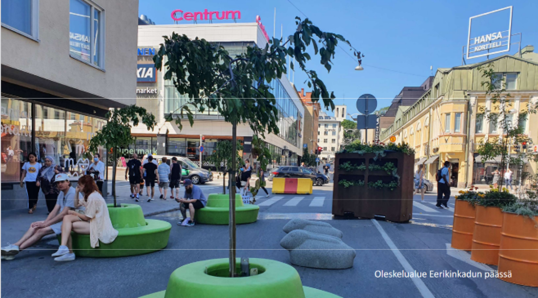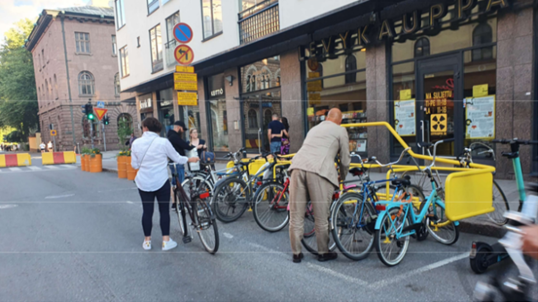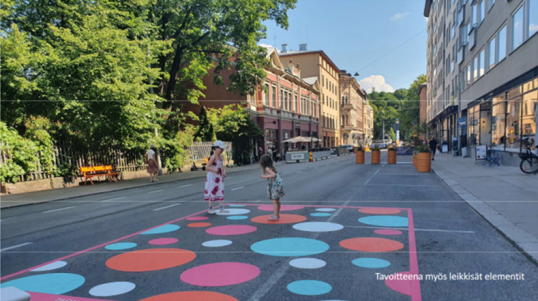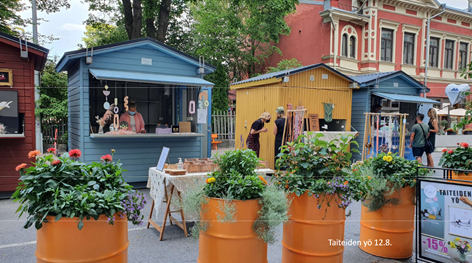- Topic
- Traffic and demand management
- Country
- Finland
- Resource type
- Case study
First published on 17 August 2022.
The centre of the Finnish city of Turku, since its rebuilding after the Great Fire in 1827, is formed by a rectangular block-system of streets. With the River Aura at its southern edge and green parks on the city’s hills, public space is dominated by wide roads that provide sufficient space for pedestrians, but are mostly used for cars and other motorised vehicles. The city is working to turn its centre into a more liveable and walkable area. Hence, in November 2020 it began the ‘Turku walking and lounging development programme’.
One objective of the programme was to turn the streets into spaces that have people as the main users in mind. In July and August 2021, Turku decided to run an experiment to test what a street design focused on people would look like and how people and specific stakeholder groups, such as retailers or residents, would react to it. The experiment took place in the city centre street, Kristiinankatu, and was called the ‘Summer Street’. One part of the street was closed to motorised traffic and revamped into a public seating area for socialising, with a market space in its northern part and an extended outdoor gastronomy space in the southern part. A diverse set of stakeholders, such as the street’s entrepreneurs and residents were involved in the preparation and the choice of the installations. The city and stakeholders brought a range of economic and cultural activities to the Summer Street, including an outdoor stage where anyone could book a timeslot to perform.
A detailed evaluation of the experiment showed that it had a high acceptance rate by the street’s retailers and gastronomists, as well as from visitors and the public. However, the reactions of residents were mixed with slightly more than half supporting the idea, while the others opposed it. In contrast to before the experiment, there was life in the street with people making use of the installations and service offers. There was no traffic problems or congestion from closing part of the street to motorised traffic. The newly created street environment was rated as a definite improvement and calls for this to be repeated in the future grew louder. Hence, in the summer of 2022 Turku reinstalled the Summer Street with a spatial extension to a larger part of the road.
Context
Turku is home to 193,200 inhabitants and is Finland’s third largest city. Its inner city was rebuilt after the Great Fire of Turku in 1827 and is today structured in rectangular blocks with wide avenues as the central access routes. Central elements of the city centre are the River Aura at its southern edge and seven hills. Green spaces are mainly concentrated on the hills, which has resulted in steep green parks and a few green structures in the more level parts of the inner city. In recent decades, the public space alongside the River Aura has been revamped into a long stretch of high-quality public space. Turku is now working on improving its city centre to create an attractive location for living, working, shopping and leisure. One challenge is how to work with the streetscape in the centre, which includes wide road space for cars and other motorised vehicles with sufficient space for pedestrians.
With this in mind, Turku took part in the URBACT III network Space4People project that focused on ensuring that public space met people’s needs, while taking the focus away from providing space for motorised traffic. Within this scope, the city government decided in November 2020 to start the Turku ‘walking and lounging development programme’. One of its elements was to run a temporary experiment showcasing how streets in the city centre could be used as spaces for people. The street chosen for the experiment was Kristiinankatu, the busiest walking and cycling avenue in the city centre. The street connects the core of the city centre to the popular pedestrianised area alongside the river. It is home to many brick-and-mortar retail spaces, such as restaurants, bars, hairdressers, beauty salons, record stores, design stores and second-hand stores. There are two parking facilities located at the northern end of the street close to the central shopping centre, Hansakortteli. There is little greenery, such as trees, and no outdoor furniture, such as benches on which to sit and rest. The experiment focused on the middle section of Kristiinankatu, which is where most of the stores and gastronomy are located and thus left access open to parking facilities at the northern end of the street.
In action
The goal of the Summer Street experiment was to improve conditions for walking and socialising, and thereby increase the attractiveness of the city centre and revitalise its street scene. The experiment ran for the months of July and August 2021. The Summer Street installation saw a range of changes to the street:
Access for active mobility users and motorised traffic
The street was closed to motorised traffic, except access for residents, delivery to retail outlets and gastronomy and emergency services. Pedestrians and cyclists were able to cross the Summer Street area without any limitations. Additional bicycle-parking options were added using parking stands in the shape of a car to demonstrate a better use of the public space.
Placemaking installation
The northern part of the Summer Street was the focus of placemaking activities (planning, design and management of public space). Seating islands with trees, small animal-shaped rocks for sitting on, as well as removable greenery, such as living walls or plant containers, were placed in this section.
Outdoor gastronomy in the southern part of the Summer Street
To benefit from the concentration of gastronomy outlets in the southern part of the Summer Street, restaurants, bars and cafés placed additional outdoor seating in the street, with added greenery to improve the comfort of their customers.
On-street market
Installations in the northern part of the Summer Street included a market area with several stalls and information stands in wooden huts. These were also used for a youth entrepreneurship market, which was the result of a public competition called ‘Ignite Turku’. The market was open from 12 July to 1 August and novice entrepreneurs could apply for a stall to present their services and products. They also received support from city employees on how to implement their business ideas. For the remaining time of the Summer Street, the market was used for the sale and promotion of local goods or as a service point to sell tickets and bracelets for other ongoing events, such as the Turku Music Summer Festival.
Event carpet
The Summer Street was home to a new experiment, the event carpet, which also originated from the ‘Ignite Turku’ competition. During the summer of 2021, Turku tested this new feature in Kristiinankatu and one other location. The event carpet was a 4m by 6m painted area that anyone could rent as a stage for their performances. The event carpet was booked about 80% of the time and the City of Turku also used the space to promote the 10th Anniversary of Turku as the European Capital of Culture.
Games for children
The design of the event carpet also served as a place for children to play. The coloured and dotted surface invited children to jump and be active. As an additional option, the Summer Street provided a scavenger hunt variation called “Find Leppis the Ladybug”. Stickers of the ladybug were placed and hidden along the street and children had to find them and could then email their solution to city authority employees.
Experimenting with greenery
Amongst the placemaking installations, the city experimented with removable greenery called ‘the living wall’. It placed metal boxes with plants in the street to learn if they added to the atmosphere and therefore encouraged people to stay, as well as how they worked as a greening element in themselves.
Communication and marketing
The Summer Street was promoted and marketed using Turku’s paper bulletins, the city’s website and social media channels. It also received high coverage in newspapers and online articles. On the website, a communication team provided details of the experiment in 3 languages: Finnish, Swedish and English.
Retailers and gastronomists that benefited from the Summer Street created their own Instagram account for the Summer Street to promote events, sales offers and customer benefits during the summer of 2021. The account had around 100 contributions and 15 dedicated posts. The Instagram channel continued beyond the duration of the pilot Summer Street.
The role of local work groups
The Summer Street was planned within the framework of the local working group of the URBACT III Space4People network. Its members were a cross-departmental unit of the city administration as well as retailers, gastronomists and residents of Kristiinankatu. Organisers of other events and festivals, as well as of the ‘Ignite Turku’ competition, cooperated closely to better exploit the opportunity of cultural events and the Summer Street experiment. The plans for the Summer Street were discussed with a larger group of stakeholders, such as the elderly council, the youth council, the disability council, the Turku City Centre Association, union representatives, the Turku Club, parish associations and housing associations.
Results
Since the Summer Street was the first experiment of its kind in Turku, the city used a wide set of evaluation methods. The effects were evaluated at 3 different levels:
- people's movement and well-being;
- user satisfaction and experience; and
- implementation process, interaction and communication.
The effects of the experiment on people's movement and presence
Turku used measures such as traffic counts and the Stationary People Mapping Tool of the Gehl Institute to evaluate the effects on people’s movement and presence.
The traffic counts were undertaken in April and June 2021 before the experiment and in July and August during the experiment. The counts were undertaken on weekdays at midday and in the afternoon. Both the number of pedestrians and cyclists crossing the area were similar during June, July and August, while April’s figures were considerably lower. Cars driving in the street dropped due to the ban to below 10 cars per hour during the time of the Summer Street compared to above 200 in April and June. Compliance with the rules for entering the area during the experiment was high; only one car was observed in the area that did not have any of the exemptions. However, the fact that the number of pedestrians and cyclists remained similar during the experiment, compared to before its start was a surprising result. The reason was thought to be that Kristiinankatu was already one of the most used connections from the core area of the city centre to the riverside by cyclists and pedestrians before the experiment. The survey results from street users revealed that pedestrians and cyclists valued the experiment as it made the street more pleasant than before.
The results of the Stationary People Mapping highlighted a clear increase in the use of the street as a place for sitting and socialising. Measurements were undertaken in June, July and August, which observed where people stayed and what they did using 20-minute time slots at midday and again in the afternoon. The observations highlighted that the experiment had encouraged people to stay and visit and use the services that were available. In line with the set-up of the street, most activity took place in the northern part, while a clear distinction was visible compared to the gastronomy part on the southern street, which become alive and well used in the evening.
User satisfaction and experiences
Turku invited all users of the Summer Street to comment on how happy they were with the experiment and to share their experiences. The survey addressed the implementation of the Summer Street and the effects on how people were able to move, as well as specific sections on the youth entrepreneurship market and Turku’s ‘use your city’ concept. The survey had 140 responses. Three quarters of respondents rated the experiment as a success and only one in five saw it as a failure. The latter group represented a larger share of the residents of Kristiinankatu. Respondents delivered suggestions for improvements for the next experiment, focusing on using more greenery, more street art and performances or events, and adding food stands or kiosks. Proposals called for a more organised and uniform character of the installation. In terms of accessibility, the shared street area that could be used by all active modes was confusing for some of the respondents.
Turku also sent a specific survey to the entrepreneurs and the residents of the street after the experiment had ended. It collected opinions on the level of success of the Summer Street, its comfort, its traffic arrangements and future hopes. The survey results revealed a high level of satisfaction with more than 90% of respondents rating the experiment as successful or mostly successful and supported a continuation of the Summer Street in the coming years. More than 80% welcomed the fact that cars had been removed from the street to a large extent and saw only positive effects from this.
Of the retailers, 73% saw a positive effect on their business during the time of the experiment. No retailers reported negative effects. Suggestions for the future replication of the Summer Street suggested better marketing, an increased functionality of the installations and the use of more high-quality material and furniture. Entrepreneurs expressed an interest in taking a stronger role in the planning and implementation of future Summer Streets.
The replies from the residents showed a clear contrast of opinions and experiences: 65% of respondents rated the experiment successful or mostly successful, whereas 35% saw it as a clear failure and not pleasant. Negative comments focused on the higher number of people hindering residents from driving their car to its parking space, the higher noise level and that the design of the installations was not appealing. The views on the reduction in car traffic saw a similar split of opinions with 53% welcoming the move and 41% reporting negative effects.
Implementation process, interaction, and communication success
Turku had two main objectives for the Summer Street experiment: to test temporary installations to improve walking and cycling conditions, as well as to increase the attractiveness of the city centre and add life to the streets. Both have been achieved to a large extent. The Summer Street improved the walking environment and increased the opportunities in the centre. More people used the street during the experiment than beforehand. Users reported better walking quality although this did not translate to a higher number of pedestrians using the street. The experiment had positive effects on city life and the businesses located in the Summer Street. The street saw activities that enlivened the street, such as the youth entrepreneur market and connected events in the city.
The Summer Street experiment was a learning experience for all parties since nothing similar had ever been done in Turku. Cooperation within the city administration and the implementation of the experiment as a city activity worked smoothly. However, the high number of stakeholders and their many interests constantly presented new challenges and surprises along the way. Stakeholders, especially the entrepreneurs, added many valuable contributions to the Summer Street, such as cooperation with the Summer Music Festival, night sale activities or the ‘night of the arts’. Other good ideas, such as a street flea market did not happen this time but are potentially valuable for any replication of the Summer Street.
The traffic arrangements on the street worked well and did not cause any difficulties or congestion in the neighbouring streets. Non-compliant driving in the street was observed only to a marginal extent. Improvements could be to better mark and communicate the replacement of disabled parking spaces and the cycling route within the street. The installations faced only minor vandalism such as when the planting barrels were knocked over a few times. Skating and littering left marks on the benches that were difficult to remove.
Media reporting and responses
The Summer Street experiment saw high interest from the media, especially local newspapers. About 20 articles were published on the Summer Street ranging from high media presence on the opening day to constant reporting on its activities and the opinions of the Turku population. Newspaper coverage even reached the national level with an article on the Summer Streets in Turku, Vaasa and Mariehamn and their effects on business operations. In social media, the experiment sparked a lively discussion, especially in the Facebook accounts of local newspapers and Turku's environmental and planning citizens' discussion group.
Challenges, opportunities and transferability
Turku’s Summer Street experiment 2021 was a success, as is clear from the calls from entrepreneurs, the public and some residents for it to be repeated. In 2022, the Summer Street took place in Kristiinankatu during July and August once more after a lively political and public debate during the spring. The Summer Street 2022 was extended in the direction of the River Aura.
Although the planning and implementation of the Summer Street 2021 involved a large range of stakeholders, Turku sees room for improvement to give residents, entrepreneurs and cultural players a larger say in the details of the installations. These stakeholders called for more and earlier involvement and increasing the use of high-quality material and equipment. The first experiment in 2021 was limited to equipment that was already present in the stock of the city. Earlier involvement influences the timeline for its planning; it has been suggested that this should be longer than the 5-month planning period used in 2021 to give extra time to coordinate the contributions of stakeholders.
Planning and implementing an experiment in a public space requires different permits and coordination with public services, such as the emergency services. Aspects to consider are: traffic arrangements and signposting for diverting the traffic flow; rescue plans; checks relating to permits from building control; consultation with the police; and the coordination of permits needed by retail and gastronomy for the outdoor spaces.
Experiments such as the Summer Street also result in an extra workload for the city administration’s employees on top of their existing activities. Arranging coordination between the necessary officials can affect the timeline of the preparation, for example setting regular and extraordinary meetings that fit into everyone’s schedule. If schedules are too tight, contracting external service providers or installing a coordination group with stronger decision-making powers are options to consider for tasks that do not have to be undertaken by the public administration.
The planning of the experiment was also hampered by COVID19-related restrictions. Most of the engagement and participation had to take place online. Techniques used by the city to showcase the ideas of participants, such as online whiteboards, were limited. People were also less used to using online variations of interactive elements, such as maps and voting.
The experiment is certainly transferable to other cities. The summer of 2021 saw Summer Streets in different cities of Finland, as well in other EU Member States. The lessons learnt, the selected installations and the evaluation of the experiment as undertaken by Turku demonstrate good practice for any city that wants to start a Summer Street experiment.
Most of all, the experiment successfully triggered a public and political debate on how the city centre of Turku should look, with a focus on meeting people’s needs, as proven by the calls for a repeat of the Summer Street in 2022.
Author: Claus Köllinger
Views and opinions expressed are those of the author(s) and do not reflect those of the European Commission.
Photo credits: City of Turku






